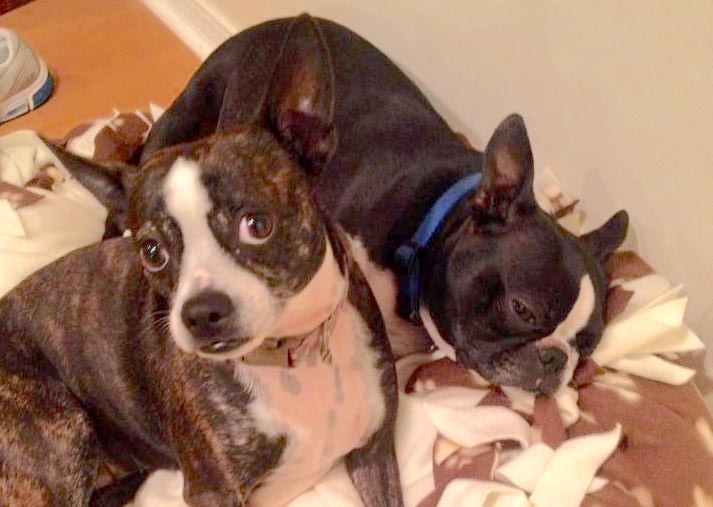Did your dog just have a seizure? Is this your first experience with seizures? Is this your foster dog’s first one?
Don’t panic. You’ve got this.
The purpose of this blog post is to talk about the dog’s FIRST seizure or the foster parent’s FIRST experience with a seizure. This blog post does not cover diagnosis or treatment protocols for managing seizures in dogs.
Not every seizure is a medical emergency, but don’t dismiss one as no big deal, either. Hopefully, your rescue organization has a protocol in place to help guide you through an event such as this. It’s not fun to be home alone with no one to talk you through or not knowing who to call or what to do.
Disclaimer: I am not a veterinarian or an animal behaviorist. I write based on my experiences and understanding of literature I’ve read. If you are in need of medical or behavioral help for your dog, please seek professional guidance. I hope you find this post useful.
How Do I Know My Dog Is Having A Seizure?
A seizure is defined as a temporary, involuntary disturbance of normal brain function that can be accompanied by uncontrollable muscle activity. There are many different types of seizures, the most obvious and frightening is the grand mal, or “full blown” seizure.
A seizure has three parts: The pre-ictal phase, the ictal phase and the post ictal phase.
- pre-ictal – your dog may have been acting “not quite itself’, as if they are having an off day. They may seem more anxious, restless, seek out your attention, they may have more salivation. One dog in my foster program had an increase in tear production and had increased flatulence – some unique manifestations of the pre-ictal phase.
- ictal – the actual seizure phase
- post-ictal phase – the period after the seizure activity stops. The dog regains consciousness and is recovering from the episode.
Symptoms you might see: the dog appears confused or disoriented, may pace or act restless. The dog may have temporary blindness, bump into objects. They may act fearful and try to hide.
The severity of the post-ictal phase has no direct correlation with the severity of the seizure, and may last a few minutes or several hours.

Grand Mal Seizures
During a grand mal seizure, a dog will lose consciousness and the muscles of the body will stiffen and contract erratically. You may see a dog jerk or twitch, sometimes violently. The body may appear stiff while the legs and paws “paddle”. The head may be drawn back, neck stretched out. Often, urination, defecation, and salivation or foaming at the mouth will occur. Foaming does not mean your dog has rabies.
Grand mal seizures last a few seconds to several minutes.
A dog that has a prolonged seizure (3-5 minutes) may be considered to be in a medical emergency. CALL A VET ON CALL.
Seek veterinarian assistance immediately if your dog is seizing for 5 minutes or longer. This is an emergency. Body temperature spikes dangerously high and can cause brain damage.
Cluster Seizures and Statis Epilepticus
Cluster seizures are identified as multiple seizures in a short period of time, with periods of normal consciousness in between. There can be just a few minutes in between each one or there can be several hours in between. Cluster seizures usually require emergency veterinary care.
Status epilepticus is one continuous seizure lasting quite a long time, or many seizures happening one right after the other, with no periods of normal consciousness between each episode. If a dog is in status epilepticus, this is a life-threatening emergency, get the dog in your car and then call the animal emergency number. Many dogs in status epilepticus require IV medications to stop the episode.
It can be difficult to determine if your dog is having a cluster seizure or if your dog is in status epilepticus. What is important – both require emergency veterinary intervention; both can be life-threatening.
There are other types of seizures such as partial seizures and focal seizures. If you think your dog is exhibiting odd behavior that is episodic and not related to any particular stimulus, (biting at the air, walking in circles, unexplained periods of agitation for example) notify your veterinarian and get in for an evaluation. It may not be seizure related, but your vet should check it out.
Is My Dog In Pain During The Seizure?
No, and they are not suffering. They are likely aware of your presence, so stay with them, talk to them, and soothe them with your voice and gentle touch. You can hold them, (but know they may involuntarily lose their bladder or bowel!) and you should make sure their head is protected.
Why Did My Dog Have A Seizure?
It’s hard to say, and time will tell. That doesn’t really answer the question, but it’s the best answer available.
A seizure is not a condition. We don’t say, “my dog has seizures”. A single, isolated seizure is a medical event. Multiple seizures are a symptom of a condition.
Some dogs have one or two seizures and never have another. Ever.
Some dogs have a seizure and, through evaluation by a veterinarian, it is discovered the dog has a medical condition or was exposed to a toxin of some sort.
Some dogs, through a painstaking long process, are eventually diagnosed as having a form of epilepsy or even a brain tumor.
How Do I Stop The Seizure?
You can’t, is the short answer. But you should intervene.
[There is a prescription medication that can be given rectally to help possibly get a dog out of status epilepticus, however – it is not something that is available “just in case” for your first-aid kit. The medication is usually reserved for dogs that have severe seizures, cluster seizures or have a history of prolonged seizures.]
What you can (and should) do:
During The Seizure:
Maintain Safety:
- Move your dog to the floor.
- Clear the area around your dog
- Move furniture and objects away
- Move the dog away from walls
- Protect their head
- Put your other dogs away
- Put them in a different room… If there are other humans at home, delegate this task to another person.
- Your other dogs are likely confused about the seizure activity and may try to intervene. Don’t set them up to behave in an unhelpful or dangerous way. They can kill or injure your seizing dog.
- DO NOT put anything in the dog’s mouth in an attempt to grab the tongue.
- Doing so can get you bitten or cause the dog an injury.
- Dogs do not swallow their tongues when seizing, there’s no need to intervene in this way.
- DO speak softly to your dog and comfort/reassure them.
- You can hold them and touch them. Even if you are upset and scared, (and you will be!) try your best to be calm and soft-spoken. The seizure will most likely stop soon.
- If you live alone, call someone and put them on notice that you might need a ride to the animal ER.
- Call your rescue administrator or delegate this task to someone.
Observe And Make Mental Notes
- Duration
- It is important, best you can, to time the seizure. A seizure lasting a few seconds is going to feel like several minutes. I know you are focused on the dog, but a quick look at the clock as soon as you see the first signs and then again as soon as the seizure stops. One of the first questions your veterinarian will ask is, “How long did the seizure last”?
- Observed Behavior –
- Make notes of what your dog is doing during the seizure. During grand mal seizures, dogs often are laying on their sides, “paddling” their paws. They may foam at the mouth (this is not a sign of rabies) and they may pee and/or poop involuntarily. Sometimes, dogs may have “vocalizations” during a seizure where they yelp or cry out. This does not mean they are in pain. They are not crying out in pain. It’s just another involuntary behavior. It is an upsetting sound, no doubt about that.
- First Aid
- Sometimes, especially if the seizure lasts a couple of minutes or longer, a dog’s body temperature can spike. My opinion? Always assume that the temperature is elevated and grab a cool (not ice cold!) cloth and lay it on your dog’s belly, back, neck. bottom of the paws. Do not use ice water; it isn’t necessary. You can also add the cool air of a portable fan if you have time to grab one! Some people say that an ice pack placed on the dog’s lower back helps shorten the duration of a seizure sometimes, but in terms of cooling down your dog’s core temperature, cool cloths are good.
After The Seizure:
Maintain Safety
Post-Ictal Peroid
After the seizure, your dog may experience what is called the “post-ictal” period. This is the recovery period after the seizure, and it can last a few minutes to an hour or more.
- Your dog may be:
- confused, fearful, agitated,
- pacing,
- they may not recognize you
- they may seem blind – this is not uncommon, and it is temporary
- You will want to supervise them. Allow them to move about, but don’t leave them alone – don’t let them navigate heights like stairs, and don’t let them wander the yard alone.
- Support Glucose levels. We’ve always rubbed a little honey or Karo syrup on the dog’s gums right after the seizure stops – to help boost blood sugars. Others use an all-natural, chemical-free vanilla ice cream. Not a lot, a tablespoon or so for little dogs and more like a half cup for big dogs. Giant breeds probably could tolerate a cup.
- Decide if feeding is safe. As your dog starts coming around, they may seem thirsty or hungry or sleepy. You can feed them a small meal and water if you are pretty darn sure they are coherent and close to being back to normal. If the dog is in status epilepticus, you risk causing aspiration. It’s fine to let your dog sleep. They may sleep for the entire day.
- Observe and make notes – start a seizure log or seizure journal.
- Write notes about what your dog is doing during the post-ictal period, and how long this period lasts. Even if you think the behavior has nothing to do with the seizure, write it down anyway.
- Write notes about what your dog is doing during the post-ictal period, and how long this period lasts. Even if you think the behavior has nothing to do with the seizure, write it down anyway.
- Recall the mental notes from the seizure period.
- Write down what you observed and the duration, as discussed above.
- Write down anything you may have noticed prior to the seizure.
- Was there a pre-ictal period that you now remember? Was your dog behaving in any atypical way? What were they doing?
With any first seizure, you should probably call your vet to see what they say. They may not see this as a life-threatening situation, but you won’t know unless you call.
I’d rather call and have peace of mind, than to not call with dire consequence.
It’s The Middle Of The Night! When To Contact Your Veterinarian
MY ADVICE IS TO ALWAYS CALL the veterinarian on call when a dog experiences their first seizure.They will tell you if the dog needs to come in or not.
A single seizure lasting no more than a couple of minutes may not be considered a medical emergency, but you (or your rescue administrator) should notify your veterinarian anyway. If the dog has never had seizures before, the vet will want to do an evaluation, and they can advise if it is safe to wait until the clinic is open in the morning. Sometimes, a cause can be found by conducting routine bloodwork and urinalysis.
Single seizures lasting 3-5 minutes could be considered a medical emergency. A seizure lasting 5 minutes or longer IS a medical emergency.
A dog that has had two seizures in less than a 24-hour period regardless of the duration of the seizure definitely needs to be seen by a veterinarian. Call them after the second seizure.
In Summary:
- During a seizure, stay calm, put the dog on the floor where they cannot get injured, and reassure your dog. Put other dogs away in another room. Cushioning the dog’s head is a nice thing to do.
- Look at the clock – get a good idea, best you can, of when the seizure started and stopped.
- Cool down the dog’s body temperature using cool (not cold) cloths. Turn on a portable fan to blow cool air
- Stay with the dog during the post-ictal period. Allow them to pace, but keep them from staircases or from wandering blindly in the yard. They may have temporary blindness and be confused or disoriented.
- Call a veterinarian. It will give everyone peace of mind. So what if the vet on call yawns when saying it is not an emergency. At least you’ll know.
If your dog has two seizures in less than a 24-hour period, they need an evaluation by a veterinarian.
If your dog has one seizure lasting longer than 3 minutes, contact a veterinarian on call for further directions. A seizure lasting longer than 5 minutes warrants immediate emergency care.
In other words, call a veterinarian. Oh. Did I say that already?
Write notes, write notes, write notes.
If your dog has frequent seiure activity going forward, a seizure journal is going to be your best way to help tailor a care plan.
Final Intstructions On Navigating Your Dog’s First Seizure
Where have you posted your emergency veterinarian numbers?
You haven’t? DO IT NOW.
- Put it in your phone’s contacts. Use ICE-DOG, (ICE=in case of emergency) EMERGENCY – DOG, or VET Emergency, or some other name where you can pull it up quickly. I have 15 veterinary contacts in my phone – don’t ask me to remember the name of the emergency clinic!
- Keep the number on your refrigerator or kitchen bulletin board if you have one.
You really don’t want to be googling where the nearest animal ER is when you are having a veterinary emergency.
In short:
- stay calm, do not panic.
- provide a safe space for the seizing dog.
- time (best you can) the duration of the seizure
- GO to the ER if the seizure lasts too long.
- call the on-call veterinarian for instructions.
I hope you never have to witness any dog having a seizure. But if you do, you have some guidance here to help you make quick decisions that can provide your dog the best support during their first seizure.

For More Reading On Seizures:
A Guide to Seizures and Convulsions in Dogs
Canine Seizures And Epilepsy – Don’t Panic –this is a really good read.
Popular Posts
Need To Quarantine Your Foster Dog? Here’s How
The Elizabethan Collar: 9 Ways To Help Your Dog Adjust To Wearing One
The Essential Equipment Every Foster Home Should Have




